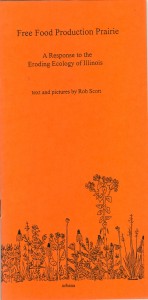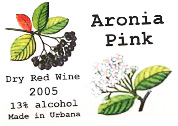 While there was much research carried out by other members of the Urbana Permaculture Project, the following work came from Robert Scott. The following research is not representative of the wider collective knowledge of the Urbana Permaculture Project. No further comment.
While there was much research carried out by other members of the Urbana Permaculture Project, the following work came from Robert Scott. The following research is not representative of the wider collective knowledge of the Urbana Permaculture Project. No further comment.
—–
Free Food Production Prairie (2001) PDF.
The text of “Free Food Production Prairie” was published as a booklet in 2001. The text describes 10 edible/medicinal plants that are native to Illinois. It was formatted as a brief “field guide” for the ten best prairie species for Illinois permaculture applications. The text illustrates how few food staples have been derived from Illinois’ indigenous flora. Includes line drawings of all ten species.
This pagination can be printed double-sided to produce a brochure.
Scott, R. 2001. “Free food production prairie.” Brochure. Retrieved at: http://robscott.net/upp/research
—–
Legitimate Questions (2004) PDF.
This brief article calls for permaculture educators to focus on design by emphasizing questions that do not have known answers. In other words: stop repeating the already-established permaculture answers.
Scott, R. 2004. Legitimate Questions. Permaculture Activist 54: 57-58.
—–
Illinois Permaculture Handbook (2005)
Scott, R. 2005. Illinois Permaculture Handbook. Unpublished Masters’ Thesis. University of Illinois at Urbana-Champaign. Department of Natural Resources and Environmental Sciences.
—–
Black Walnut Polyculture (2007) PDF.
Abstract. Black walnut (Juglans nigra L.) is a temperate tree grown for nuts and wood, but it is allelopathic to certain plants and animals. We compiled reports of valuable black walnut companion crops which may be grown in the short term (<15 years after planting walnut trees), medium term (15–30 years), and long term (>30 years). There are many black walnut companion cropping systems for the short and medium term, but there are few for the long term. Companion crops for black walnut serve multiple functions, including nitrogen fixation, added yields, the development of straight walnut stems, and added protection from forest pests such as deer. Black walnut polyculture is a viable alternative worthy of further development and implementation.
Scott, R. and W.C. Sullivan. 2007. A Review of Suitable Companion Crops for Black Walnut. Agroforestry Systems 71(3): 185-193.
—–
Aronia Description (2007) PDF.
Abstract. Black chokeberry (Aronia melanocarpa Michx.) has several potential uses as a cultivated horticultural crop. Cultivars have been bred for larger edible fruits and ornamental value. The fruits are high in pectin and anthocyanins, and have no known pest problems. The somewhat unpleasant taste of the raw fruit may limit its use to blended juices, liqueurs, and medicinal products.
Scott, R. and R.M. Skirvin. 2007. Black chokeberry (Aronia melanocarpa Michx.): A semi-edible fruit with no pests. Journal of the American Pomological Society 61(3): 135-7.
—–
Ecology of Fermented Foods (2008) PDF.
Abstract. Fermented foods arise in the human relationship to the microbial environment. Human survival is connected to yeasts and bacteria that produce lactic acid and alcohol in preserved foods. This constitutes a fermentation ecosystem that embodies the succession of species, partitioning of resources, disturbance and equilibrium found in larger ecosystems. Fermented foods are preserved by microbes that live in food storage vessels. In many societies, the contribution of fermented food has been central. Fermentation ecosystems can be used as an engaging instructional tool to illustrate ecological concepts and lead to a more complex understanding of the ecology of human nutrition.
Scott, R. and W.C. Sullivan. 2008. Ecology of Fermented Foods. Human Ecology Review 15(1): 25-31.

Wine Fermentation Trial – August 2004 – Urbana, IL
